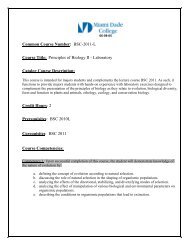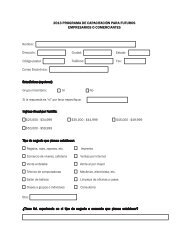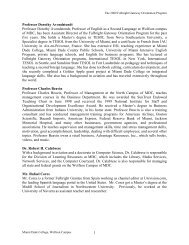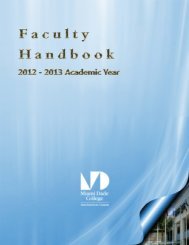Catalog 2010-2012 - Miami Dade College
Catalog 2010-2012 - Miami Dade College
Catalog 2010-2012 - Miami Dade College
You also want an ePaper? Increase the reach of your titles
YUMPU automatically turns print PDFs into web optimized ePapers that Google loves.
M D C 2 0 1 0 - 1 2 C A T A L O G 3 9<br />
A c a d e m i c R e g u l a t i o n s<br />
Attendance in Class<br />
Students are expected to attend every<br />
class meeting and to arrive on time.<br />
Students who expect to miss a class, or<br />
those anticipating tardiness, should let<br />
the instructor know. In most courses,<br />
attendance requirements are listed on<br />
the syllabus. It is the responsibility of the<br />
student to make up work missed.<br />
Students expecting an extended<br />
absence should notify the Dean of<br />
Student Services.<br />
Audit<br />
Students desiring to enroll in a course<br />
at <strong>Miami</strong> <strong>Dade</strong> <strong>College</strong>, but who do not<br />
wish to receive a grade or credit for the<br />
class, may elect to audit. Students will<br />
not be allowed to change from an audit<br />
status to a credit status (or from credit to<br />
audit) after the 100 percent refund date<br />
for each term.<br />
Audit courses will be included in the<br />
student’s academic record with a nonpunitive<br />
grade of “X.” Courses and credits<br />
enrolled for audit purposes do not<br />
count in the computation of a student’s<br />
full-time or part-time enrollment status.<br />
<strong>College</strong> Preparatory students, who are<br />
required to be certified as completing<br />
competency-based <strong>College</strong> Preparatory<br />
instruction, cannot be enrolled under<br />
audit status.<br />
Auditing a class costs the same as<br />
enrolling for credit, and as an audit student<br />
it can be difficult to get a space in<br />
some classes.<br />
Course Load<br />
All credit courses carry a specified<br />
number of credits. A 3-credit lecture<br />
course normally meets three hours per<br />
week during the 16-week terms, and<br />
eight hours per week during the sixweek<br />
terms. Lab classes generally meet<br />
for two hours per credit.<br />
The fall and spring terms are called<br />
“major terms” and are approximately 16<br />
weeks long. During a major term, a full<br />
course load is considered to be between<br />
12 and 17 credits. The summer term<br />
consists of two 6-week summer sessions<br />
(1st 6-weeks/2nd 6-weeks). Some<br />
courses are scheduled for the combined<br />
summer sessions of 12 weeks. During<br />
the six-week summer session a full load<br />
is considered to be 6-7 credits.<br />
It is suggested that students who are<br />
employed should reduce their college<br />
load as follows:<br />
Work Hours # Credits # Credits<br />
per week fall/spring summer A/B<br />
20 12-15 6-7<br />
25 8-11 5-6<br />
40 6-7 3<br />
Grading System<br />
Students in <strong>College</strong> credit and vocational<br />
credit courses are graded according<br />
to the following grade point average<br />
(GPA) system:<br />
A. Used in GPA computation:<br />
Grade Interpretation Point Value<br />
A Excellent 4<br />
B Good 3<br />
C Average 2<br />
D Poor 1<br />
F Failure 0<br />
U Unsatisfactory 0<br />
B. Not used in GPA computation:<br />
I Incomplete<br />
W Withdrew<br />
X Audit<br />
S Satisfactory<br />
P Progress - course requirements<br />
not completed, student<br />
must repeat<br />
NR Grade not reported<br />
by instructor<br />
“S” and “P” grades are not included<br />
in the cumulative grade point average<br />
(GPA) if the course number is below<br />
1000 or above 9000. Credits for these<br />
courses are indicated on the transcript<br />
as credits registered and earned.<br />
Final grades are available on the<br />
<strong>College</strong>’s Web site following the end of<br />
the term.<br />
Grade Point Average (GPA)<br />
Each letter grade has a point value<br />
(see above). To compute the grade<br />
ACADEMIC REGULATIONS<br />
points for a course, multiply the grade<br />
point value by the number of credits.<br />
For example, a “B” in a 3-credit course, is<br />
worth 9 points. A “B” in a 4-credit course<br />
is worth 12 points. To calculate a GPA,<br />
add the total grade point values for all<br />
courses and divide that figure by the<br />
total number of credits attempted.<br />
Example:<br />
ENC 1101 3 credits Grade A (4 points) = 12<br />
HUM 1020 3 credits Grade C (2 points) = 6<br />
ISS 1120 3 credits Grade F (0 points) = 0<br />
ISS 1161 3 credits Grade B (3 points) = 9<br />
ART 1300C 3 credits Grade C (2 points) = 6<br />
DAA 1160 1 credit Grade B (3 points) = 3<br />
Total Credits 16 Total Points 36<br />
Divide 36 points by 16 credits = 2.25 GPA<br />
In order to receive an A.A., A.A.S. or<br />
A.S. degree, or to qualify for entry into<br />
a bachelor’s degree program, a student<br />
should have a minimum 2.0 GPA in all<br />
work attempted.<br />
Repeating Courses<br />
Students may repeat courses taken<br />
at MDC if they received a “W,” “U,” “D,” or<br />
“F” grade.<br />
State rule limits the number of repeat<br />
attempts to three per course. The third<br />
and final repeat attempt (i.e., the fourth<br />
time a student attempts the course) may<br />
only be granted if the student petitions<br />
through the academic appeals process,<br />
and if the student has documentation<br />
to convey extenuating circumstances.<br />
However, a student is not permitted to<br />
withdraw during the third or fourth<br />
attempt (i.e., a grade must be assigned).<br />
Repeated surcharges apply to any third<br />
or fourth attempt. All courses originally<br />
taken and then repeated will appear on<br />
the student’s transcript with assigned<br />
grades, but the cumulative GPA will be<br />
recomputed to count the last attempt<br />
only.<br />
Specific courses, as identified in<br />
the course description section, may be<br />
repeated multiple times for additional<br />
credit. All attempts of these courses will<br />
be included within the cumulative GPA.<br />
Students should note that some state<br />
universities and colleges may not accept<br />
courses repeated for additional credit.<br />
Students should also be aware that<br />
some private colleges or universities
















